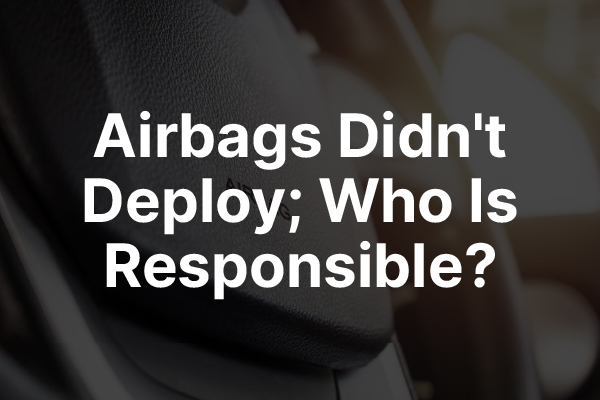
Accidents happen in a blink of an eye. One moment you are driving down the street to drop your kids off at school and the next, your car is being slammed into by another driver. The impact was strong enough to deploy the side airbags in your van, keeping your children safe, but for some reason, the front airbags didn’t deploy at all. This results in your head slamming into the steering wheel, giving you a broken nose, severe concussion, and whiplash.
Most people know they can sue negligent drivers for damages and medical expenses resulting from the crash, but what can you do about faulty airbags? Who is at fault? In this article, the team at the Hernandez Law Group, P.C. take a closer look at airbags, how they work, and what you need to know about where to seek compensation when they don’t perform as they should.
Understanding How an Airbag Works
An airbag is a safety device designed to protect drivers from serious head injuries during an accident. Airbags are made of thin, nylon fabric bags and folded into different locations of your car, such as the steering wheel.
Airbags operate by using sensors and small explosive charges. When an accident occurs, the accelerometer in the airbag will detect the change in speed. If the change in speed is greater than your vehicle’s normal braking speed, the airbag sensor will trigger the circuit. The circuit passes an electrical current through the airbags, igniting the heating element and creating a chemical explosive. The explosion results in the creation of a harmless gas that inflates the nylon bag.
Inflating less than 1/20th a second, (or 100-220 miles per hour), the speed cushions the driver’s head and neck, preventing serious damage. As soon as the heat of the driver hits the airbag, it begins to deflate as the gas escapes through the small holes around the edges.
What Do I Do If My Airbags Didn’t Deploy During an Accident?

Remember, just because you are in an accident doesn’t necessarily mean your airbags will deploy. For example, if you are sitting at a stop light and a car rear ends you, your airbags probably won’t inflate. This is because there was no drastic change in your car’s speed.
Why does the airbag work this way? Because in minor accidents, the sudden inflation of the airbag can cause more harm than good, such as causing severe skin burns from the nylon bag rubbing against your arm.
However, for more serious accidents that involve high speeds, the forward motion of the collision can result in horrific head and neck injuries, such as a traumatic brain injury. If your airbags didn’t deploy or they deployed improperly, you may be able to file a product liability claim.
Who Is At Fault for Faulty Airbags?
Depending on what caused the airbags to not deploy, different parties could be financially liable for your injuries that occurred as a result. Here are the different parties that could be responsible:
- The manufacturer: The manufacturer could be at fault for the damages if there was a defect to the airbag caused during the manufacturing process. This could either be a problem with the airbag itself or another part of the vehicle that resulted in the airbags not going off as they should.
- The product designer: If there was a flaw in the original product design, the designer may be at fault for the malfunction and resulting injuries.
- The installers and testers: The individual or team that installed and tested the airbags could be at fault if the product was installed incorrectly or wasn’t tested properly. In these cases, the entire line of airbags will likely be recalled, as it would be larger than an individual problem.
- Product distributors (car dealerships): The car dealership or the seller may be responsible for the faulty airbags if there was evidence that the car or airbag was carelessly transported. This could result in them becoming damaged before they have even had a chance to be installed.
How Can I Prove That the Airbag Was Faulty?

For your product liability case to be successful, you will need to prove the following:
- The airbags were defective. Typically, this requires expert testing to see if the same situation can be replicated and if they can find the root cause of the problem. This could be a faulty sensor or the electrical components in the airbag failing.
- The airbags should have deployed during the accident. As mentioned earlier, for the airbag to deploy, your car’s speed change must have been greater than your braking speed. Expert testimony along with the details of your accident should be able to show that the airbags should have deployed but didn’t.
- There were no alterations done to the bag. You will also need to prove that neither you nor another person tampered with the airbags and that they were still within their usual lifespan.
- Due to the airbags not going off, you sustained serious injury and damage. A medical expert, such as a doctor, must have records and testimony that show your injuries could have been lessened if the airbags had deployed properly.
Your Resource for Car and Product Liability Cases
The team at the Hernandez Law Group, P.C. is dedicated to ensuring that the individuals of Dallas, Abilene, and Amarillo, Texas have their voices heard and their right to compensation protected. Whether it was a car accident, a product liability case, or a mixture of both, we work hard to fight for the compensation that our clients deserve. Contact us today for more information on our services or to schedule a free no-obligation consultation to go over the facts of your case.
